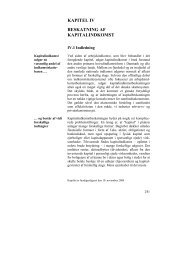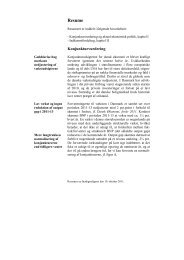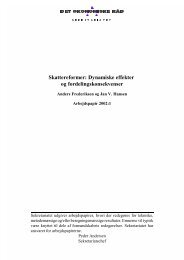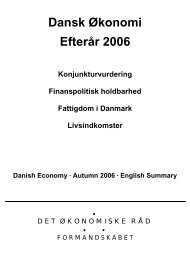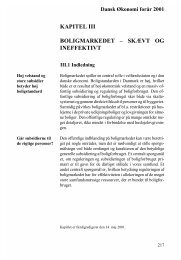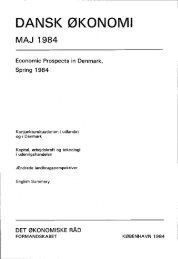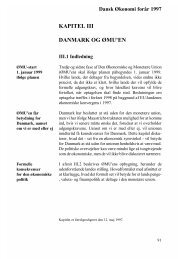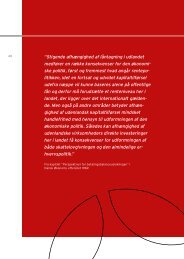The Effect of Learning and Fatigue on Preferences and WTP in a ...
The Effect of Learning and Fatigue on Preferences and WTP in a ...
The Effect of Learning and Fatigue on Preferences and WTP in a ...
Create successful ePaper yourself
Turn your PDF publications into a flip-book with our unique Google optimized e-Paper software.
<strong>in</strong>dividual’s choices can be <strong>in</strong>ternally coherent, but at the same time they can be anchored <strong>on</strong> the<br />
first choice or some <strong>in</strong>itial start<strong>in</strong>g po<strong>in</strong>t.<br />
Our results suggest that a learn<strong>in</strong>g effect is present. This is observed through a reducti<strong>on</strong> <strong>in</strong> the error<br />
variance for the last 8 CS relative to the first 8 CS. Moreover the results show that the overall<br />
preference structure differs between the two sequences <str<strong>on</strong>g>of</str<strong>on</strong>g> choice sets, <str<strong>on</strong>g>and</str<strong>on</strong>g> further analysis showed<br />
that the <strong>WTP</strong> estimates were affected to some degree. We f<strong>in</strong>d not evidence <str<strong>on</strong>g>of</str<strong>on</strong>g> fatigue effects <strong>in</strong> the<br />
applied sequence <str<strong>on</strong>g>of</str<strong>on</strong>g> 16 CS. While our results imply that learn<strong>in</strong>g effects can <strong>in</strong>deed be <str<strong>on</strong>g>of</str<strong>on</strong>g> significant<br />
structural importance when c<strong>on</strong>duct<strong>in</strong>g CE surveys, our results also underl<strong>in</strong>e that if focus is solely<br />
<strong>on</strong> obta<strong>in</strong><strong>in</strong>g policy advice <strong>in</strong> terms <str<strong>on</strong>g>of</str<strong>on</strong>g> <strong>WTP</strong> estimates, learn<strong>in</strong>g effects are not negligible.<br />
<str<strong>on</strong>g>The</str<strong>on</strong>g> paper is organized as follows. <str<strong>on</strong>g>The</str<strong>on</strong>g> follow<strong>in</strong>g secti<strong>on</strong> provides an overview <str<strong>on</strong>g>of</str<strong>on</strong>g> the exist<strong>in</strong>g<br />
literature deal<strong>in</strong>g with learn<strong>in</strong>g <str<strong>on</strong>g>and</str<strong>on</strong>g> fatigue effects <strong>in</strong> CE. Secti<strong>on</strong> 3 briefly describes the method<br />
used <strong>in</strong> the survey <str<strong>on</strong>g>and</str<strong>on</strong>g> the theory beh<strong>in</strong>d the method. In secti<strong>on</strong> 4 the design <str<strong>on</strong>g>of</str<strong>on</strong>g> the survey <str<strong>on</strong>g>and</str<strong>on</strong>g> the<br />
data are described, followed by presentati<strong>on</strong> <str<strong>on</strong>g>of</str<strong>on</strong>g> the results <strong>in</strong> secti<strong>on</strong> 5. F<strong>in</strong>ally we discuss <str<strong>on</strong>g>and</str<strong>on</strong>g><br />
c<strong>on</strong>clude <strong>in</strong> secti<strong>on</strong> 6.<br />
2. Exist<strong>in</strong>g evidence <str<strong>on</strong>g>of</str<strong>on</strong>g> learn<strong>in</strong>g <str<strong>on</strong>g>and</str<strong>on</strong>g> fatigue effects <strong>in</strong> CE<br />
In a split sample CE study, Ladenburg & Olsen (2008) f<strong>in</strong>d evidence <str<strong>on</strong>g>of</str<strong>on</strong>g> start<strong>in</strong>g po<strong>in</strong>t bias, but the<br />
impact <str<strong>on</strong>g>of</str<strong>on</strong>g> this anomaly decays as more choice sets are evaluated. <str<strong>on</strong>g>The</str<strong>on</strong>g>y c<strong>on</strong>clude that a learn<strong>in</strong>g<br />
effect effectively reduces the bias. This is clearly <strong>in</strong> accordance with the DPH. Previous studies<br />
c<strong>on</strong>cern<strong>in</strong>g the DPH <strong>in</strong>terpretati<strong>on</strong> <str<strong>on</strong>g>of</str<strong>on</strong>g> decay<strong>in</strong>g anomalies have found similar results. In a literature<br />
review, Braga & Starmer (2005) f<strong>in</strong>d some, though not unequivocal, support for the DPH. Cherry et<br />
al. (2003) <str<strong>on</strong>g>and</str<strong>on</strong>g> List (2003) f<strong>in</strong>d that people generally become more rati<strong>on</strong>al through ref<strong>in</strong><strong>in</strong>g values,<br />
4



